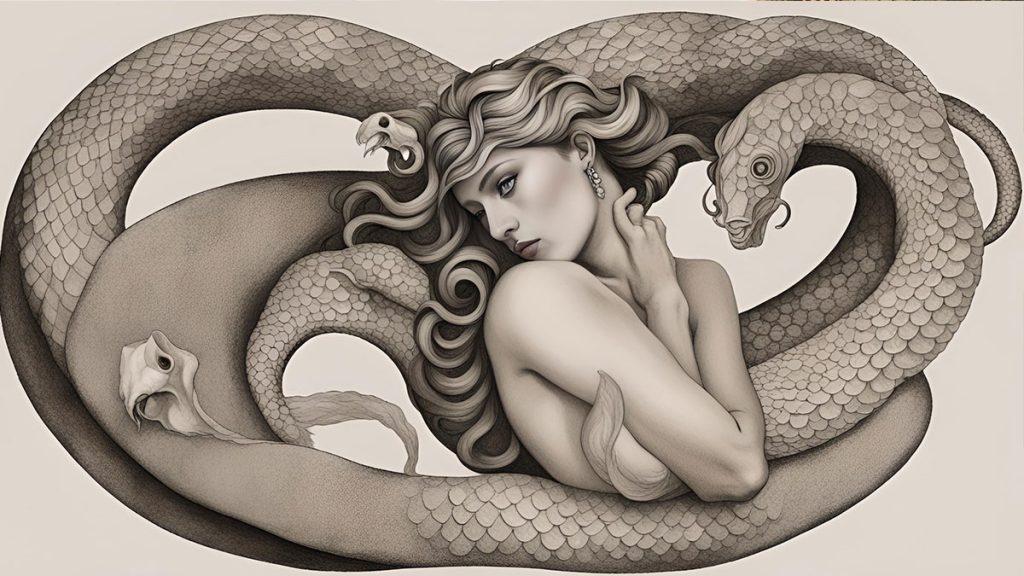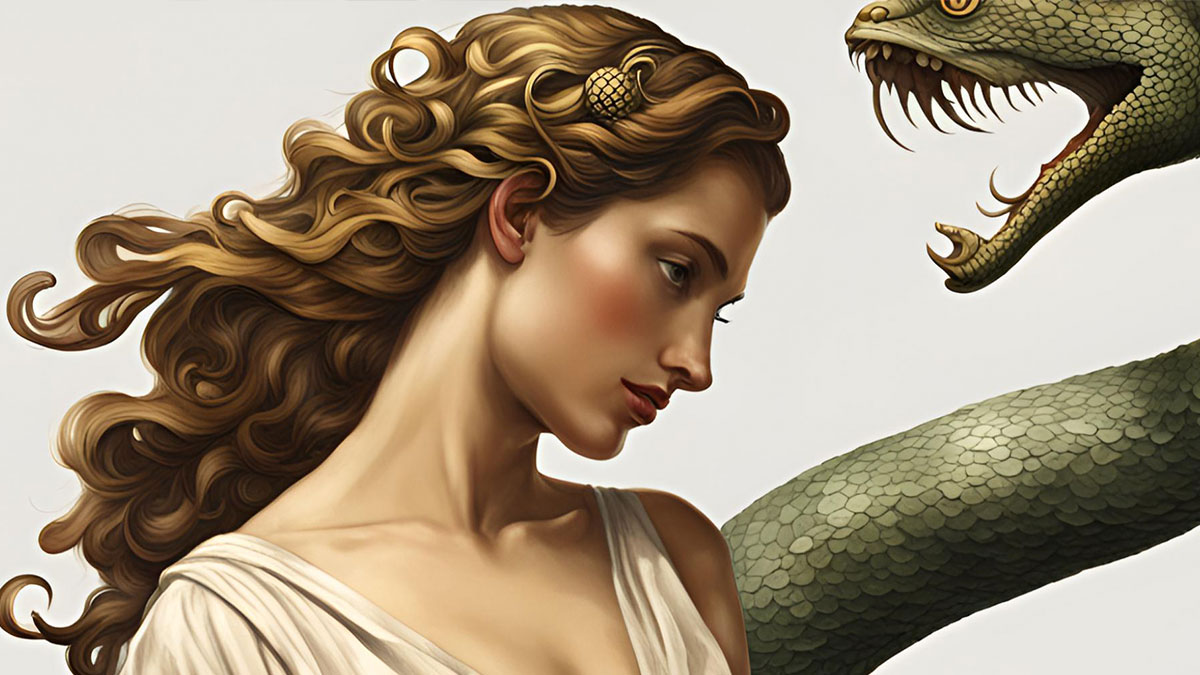Echidna is a monster from Greek mythology often referred to as the mother of all monsters. This half-woman, half-serpent creature, together with her lover Typhon, is responsible for giving birth to many of the most famous monsters found in Greek legend.
Echidna is typically described as a beautiful nymph-like woman with bright eyes and rosy cheeks. However, that’s only from the waist up, as below her loins, she is a disgusting and hideous snake or serpent creature. She usually has one serpent tail but occasionally has two. Echidna was definitely a monster; she ate raw meat and attacked and devoured humans who crossed her path.
The monster lived in a cave in the region of Arima, a mountainous area in either modern-day Turkey or Italy, depending on the source. Echidna does not seem to have left the dark bowels of her cave very often except on one particularly memorable occasion when she and Typhon waged war against the gods of Mount Olympus.
There are no images of Echidna surviving from antiquity, so we must rely on physical descriptions from literature. Most of the descriptive details about Echidna come from Hesiod, a Greek poet active in the 8th and 7th centuries BC and wrote extensively about Greek mythology in his work Theogony. Other sources include the Bibliotheca of Pseudo-Apollodorus*, written in the 1st or 2nd century AD. The Greek historian Herodotus also mentioned an Echidna-type creature in the 5th century BC when detailing the adventures of Heracles.
Hesiod described Echidna as follows,
“Not at all similar to mortal beings or to the immortal gods: divine strong-hearted Echidna, half a quick-eyed beautiful-cheeked nymph, but half a monstrous snake, terrible and great, shimmering, eating raw flesh, under the hidden places of the holy earth. That is where she has a cave, deep down under a hollow boulder, far from the immortal gods and the mortal human beings; for that is where the gods assigned her to dwell in glorious mansions. She keeps guard among the Arima under the earth, baleful Echidna an immortal nymph and ageless all her days.”
There is some debate over the parentage of Echidna; Hesiod claims she was the offspring of Phorys, a fish-tailed merman god of the sea, and his mate Ceto, another sea god who was considered to be the personification of the dangers of the deep. But the Bibliotheca of Pseudo-Apollodorus states that Echidna was born to Gaia, a primordial goddess and the personification of the Earth, and her lover, Tartarus, who dwelled in the deepest part of the underworld, where he kept the enemies of the gods imprisoned.

Echidna fell in love with Typhon, a massive, hideous monster who was also half serpent and had the heads of a hundred dragons sprouting out of his hands. Unsurprisingly, the pair went on to have many monster children, many of whom became famous in Greek mythology.
The gruesome couple gave birth to Cerberus, the three-headed dog of Hades; Ladon, the hundred-headed dragon; the Gorgon sisters, including Medusa; Orthus, the two-headed guard dog for the cattle of Geryon; the Chimera, a fire-breathing hybrid of a goat, lion, and serpent; the Sphinx, a half-woman, half-lion monster who tormented the Thebans; and many more. Hesiod wrote, somewhat kindly, “They say that Typhon, terrible, outrageous, lawless, mingled in love with her [Echidna], a quick-eyed virgin; and she became pregnant and bore strong-hearted children.”
These offspring served as the antagonists in Greek myth as they battled mortals and Gods, and they usually came off worse. Ladon, Cerberus, and Orthus were killed or imprisoned by Heracles, the Sphinx was killed by Oedipus, and the Chimera was bested by Bellerophon. The fate of their children was blamed on Zeus by Echidna and Typhon, and they waged a battle against all the gods by attacking Mount Olympus.
Typhon and Echidna’s attack caused most of the gods to flee, but Zeus stood his ground and entered into an epic battle with Typhon. At one point, Typhon had the upper hand, but after Athena aided Zeus, the king of the gods managed to defeat his opponent. Both Typhon and Echidna were hit with thunderbolts. As a punishment, Typhon was imprisoned under Mount Etna; eruptions at the volcano were subsequently blamed on Typhon struggling to escape.
According to Hesiod, Zeus allowed Echidna to go free, and she returned to her cave in Arima, where she continued to live her immortal life, occasionally devouring mortals who stumbled into her realm. However, Pseudo-Apollodorus claimed that Echidna was killed as she slept in her cave by Argus Panoptes, the hundred-eyed giant who served Hera. Pseudo-Apollodorus wrote, “It is said, too, that Echidna, daughter of Tartarus and Earth, who used to carry off passers-by, was caught asleep and slain by Argus.”
Echidna is one of numerous female monsters from antiquity
Echidna, a malevolent female creature, is part of a long tradition of such beings that originated in Greek mythology and other mythologies around the world. Author Gillian Alban noted the similarities between Echidna, Lamia, and Delphyne within Greek myth. Delphyne was a female serpent slain by Apollo, and Lamia was another half-woman, half-snake being that seduced men and consumed children.
Snake-like women are common in many mythologies: the Greek Lamia, for example, shares strong characteristics with the Qarinah from the Arabic tradition and Lilith from the Hebrew tradition. Echidna and these other female contemporaries all tap into a fear of feminine monsters, often snake-like, lurking out there, ready to prey on humanity.
Writing in the late 19th century, John Fiske claimed that Echidna and Typhon were two of many ancient creatures that inspired medieval interpretations of the Devil. Their snake-like features and qualities, combined with their underground dwelling and malevolence, inspired descriptions of the Christian Devil, argued Fiske.
References
Alban, Gillian. “Melusine the Serpent Goddess in A. S. Byatt’s Possession and in Mythology,” (2003), Pub.: Lexington Books, accessed April 26, 2024.
Apollodorus. “The Bibliotheca,” This version published 1921 and trans. by James George Frazer. Pub.: W. Heinemann, accessed April 26, 2024. *Pseudo often prefixes Apollodorus of Athens because modern historians no longer believe he was the true author.
Britannica.com, “Echidna,” accessed April 19, 2024.
Fiske, John. “Myths and Myth-makers,” (1890), Pub., Houghton, Mifflin, accessed April 26, 2024.
GreekLegendsandMyths.com, “Monstrous Echidna in Greek Mythology,” accessed April 19, 2024.
GreekMythology.com, “Echidna: The Mother of Monsters,” accessed April 19, 2024.
Hesiod. “Theogony,” This version published 2006 and trans. by Glenn W. Most. Pub.:Harvard University Press, accessed April 26, 2024.
Rosen, Brenda. “The Mythical Creatures Bible,” (2009), Pub.: Sterling, accessed April 26, 2024.
